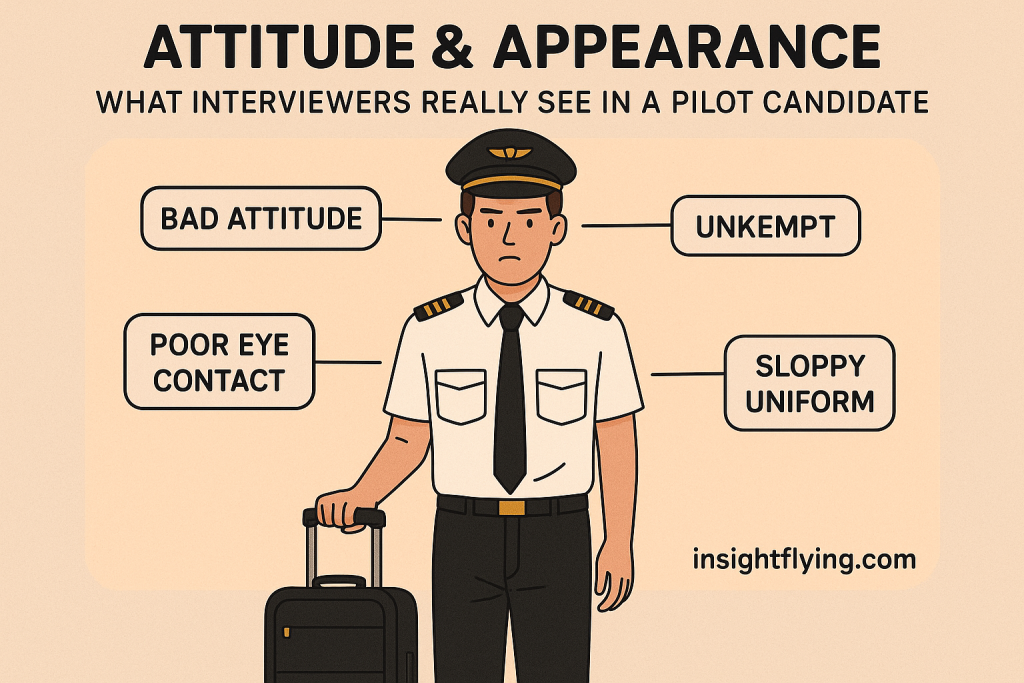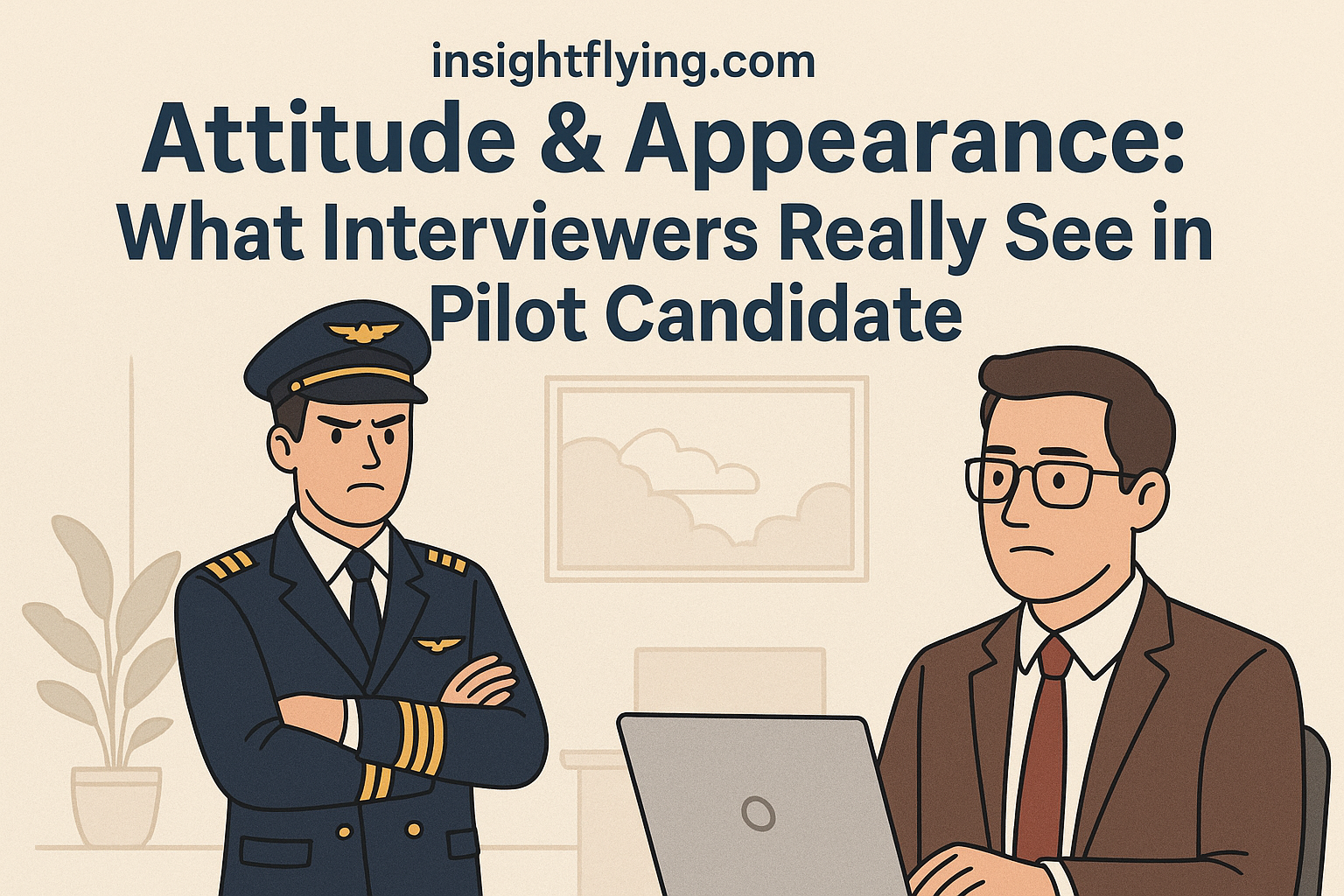ก่อนอื่นผมขอออกตัวก่อนว่า ผมไม่ใช่นักจิตวิทยา สิ่งที่ผมเขียนนี้มาจากประสบการณ์จริงและสิ่งที่ผมได้เรียนรู้จาก Professor และกัปตันที่เคยสอนผมมา และสิ่งที่น่าสนใจก็คือ ทุกครั้งที่พูดถึงคำว่า Attitude เขาจะพ่วงคำว่า Appearance มาด้วยเสมอ
Attitude vs. Appearance ต่างกันอย่างไร?
- Attitude คือสิ่งที่อยู่ภายใน เป็นกรอบความคิด มุมมอง หรือความรู้สึกที่เรามีต่อสิ่งใดสิ่งหนึ่ง คนสองคนอาจเจอเหตุการณ์เดียวกัน แต่ตอบสนองด้วยทัศนคติที่ต่างกันโดยสิ้นเชิง ขึ้นอยู่กับประสบการณ์และสภาพแวดล้อมของแต่ละคน
- Appearance คือสิ่งที่แสดงออกภายนอก เป็นสิ่งที่เรามองเห็นและสัมผัสได้จากท่าทาง การพูด การเดิน หรือแม้แต่วิธีที่นั่งเฉย ๆ ก็สะท้อนตัวตนออกมาแล้ว
เพราะฉะนั้นทั้งสองคำจึงเชื่อมโยงกันโดยตรง — Attitude จะสะท้อนออกมาผ่าน Appearance
ทำไม Attitude/Appearance ถึงสำคัญในห้องสัมภาษณ์?
กัปตันผู้สัมภาษณ์ไม่ใช่นักจิตวิทยาที่สามารถ “อ่านใจ” ได้ 100% สิ่งที่เราพิจารณาคือ ภาพที่ปรากฏให้เห็น ซึ่งก็คือ Appearance ของผู้สมัครนั่นเอง
ทัศนคติภายในของคุณจะถูกถ่ายทอดผ่าน…
- การพูด การอธิบาย หรือการให้เหตุผล
- วิธีตอบสนองต่อปัญหาเฉพาะหน้า
- ระดับความมั่นใจหรือความลังเลในน้ำเสียงและท่าทาง
ดังนั้น Appearance จึงกลายเป็นเกณฑ์ชี้ชะตา เพราะมันจับต้องได้ เห็นได้จริง และสะท้อนว่าคุณพร้อมแค่ไหนที่จะเป็นนักบิน
คุณลักษณะที่กรรมการอยากเห็น
ผู้สมัครที่มี Attitude/Appearance ที่ดีควรแสดงออกถึงคุณสมบัติเหล่านี้:
- ความมั่นใจ (Confidence) เชื่อมั่นในสิ่งที่ตัวเองรู้ และสื่อสารออกมาอย่างชัดเจน
- ความสุขุม (Calmness) ไม่ตื่นตระหนกแม้เจอคำถามยากหรือสถานการณ์กดดัน
- ความตื่นตัว (Alertness) มีสมาธิ ใส่ใจ และตอบสนองได้ทันที
- ความตั้งใจฟัง (Attentiveness) ฟังคำถามจนจบก่อนตอบอย่างมีเหตุผล
พูดง่าย ๆ คือ วิธีที่คุณนำเสนอตัวเอง มีน้ำหนักพอ ๆ กับคำตอบที่คุณพูดออกมา
ผู้สมัครแบบไหนที่ “ใช่”
บุคลิกของผู้สมัครที่กรรมการมองว่าเหมาะสมสำหรับนักบินคือ:
- มีความกระตือรือร้น และพร้อมเข้าสู่การทดสอบ
- ไม่แสดงอาการประหม่าเกินเหตุ
- มีความสุขุม มั่นใจ และควบคุมตัวเองได้
- ใช้น้ำเสียงและการแสดงออกที่น่าเชื่อถือและสร้างความมั่นใจให้ผู้ฟัง
เพราะในห้องนักบิน คุณสมบัติอย่าง ความมั่นใจที่ไม่โอเวอร์ ความนิ่งภายใต้ความกดดัน และการสื่อสารที่ชัดเจน ไม่ใช่แค่เรื่องเสริม แต่เป็นสิ่งจำเป็นสำหรับความปลอดภัยในการบิน
👉 จำไว้ครับว่า เมื่อคุณก้าวเข้าสู่ห้องสัมภาษณ์ Appearance ของคุณจะเป็นตัวบอก Attitude ที่แท้จริง และมันอาจเป็นตัวตัดสินชะตาว่าคุณจะได้บินหรือไม่

Attitude & Appearance: What Interviewers Really See in a Pilot Candidate
Before I begin, let me say this—I’m not a psychologist. What I’m sharing comes from real experiences, observations, and what I learned from professors and captains during training. And here’s an interesting point: when the professor taught me about Attitude, he always paired it with Appearance.
The Difference Between Attitude and Appearance
- Attitude is internal. It’s the mindset, way of thinking, or feeling toward something. Two people may see the same situation but respond with completely different attitudes, shaped by their background, knowledge, or personal experience.
- Appearance is external. It’s what others can actually see and sense—the way you walk, talk, sit, or even remain still. It’s the physical expression of your inner world.
This is why professors group them together. Your attitude eventually shows through your appearance.
Why It Matters in a Pilot Interview
When captains interview candidates, we’re not psychologists. We can’t “diagnose” exactly what someone’s true attitude is. Instead, we rely on appearance—the outward signs of confidence, calmness, alertness, and attentiveness.
Your attitude is communicated through:
- The way you explain or analyze a situation.
- How you respond to problems under pressure.
- The confidence (or hesitation) in your voice and body language.
And that’s why appearance becomes the decisive factor. It’s tangible. It’s what convinces the panel whether you’re ready—or whether you’ll be filtered out.
Key Qualities Interviewers Look For
If you want to score well in Attitude/Appearance, you should reflect traits such as:
- Confidence – belief in your knowledge and ability to communicate it.
- Calmness – not panicking when faced with tough or unexpected questions.
- Alertness – being attentive, sharp, and aware of what’s going on.
- Attentiveness – listening carefully before responding thoughtfully.
In short, the way you carry yourself is often as important as the words you say.
What Does the Ideal Candidate Look Like?
The desired profile of a pilot candidate is someone who:
- Shows genuine enthusiasm for being tested.
- Remains composed and not overly anxious.
- Demonstrates maturity and self-control.
- Speaks with confidence, using tone and body language that inspire trust.
Because in the cockpit, confidence without arrogance, calmness under stress, and clarity in communication are not just nice-to-have—they’re essential qualities of a safe and professional pilot.
👉 When you walk into that interview room, remember this: your appearance will reveal your attitude. And that might be the very thing that makes or breaks your chance to fly.

Leave a Reply
You must be logged in to post a comment.